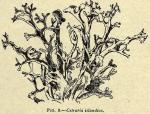
 9. CETRARIA.—ICELAND MOSS. The entire plant, Cetra'ria islan'dica Acharius. Off. U. S. P. 1890. The crisp, leaf-like lobes are cartilaginous, whitish on the under surface, channeled and fringed at the margins. A strong decoction gelatinizes on cooling; taste mucilaginous and bitter. The Pharmacopoeia calls attention to the fact that the drug is frequently mixed with pine leaves, moss, and other lichens; from these it should be freed. Constituents: It is largely composed (70 per cent.) of lichen starch, lichenin, and isolichenin, a solution of the latter producing a blue color with iodine. Unlike the gum of chondrus, it furnishes but a trace of mucic acid when treated with nitric acid. Boiling with dilute acids converts the mucilage into sugar solution. A solution of Iceland moss is precipitated by alcohol. The bitter principle, cetraric acid (cetrarin, C18H16O8), forms yellow salts, which are equal in bitterness to quinine; this bitter principle may be removed by prolonged maceration in water, or, still better, by treating the drug with twenty-four times its weight of a weak solution of an alkaline carbonate. Demulcent, nutritive, and, if the bitter principle be present, tonic; used in advanced stages of phthisis when stronger remedies are unsuitable. Dose: 30 to 60 gr. (2 to 4 Gm.).
9. CETRARIA.—ICELAND MOSS. The entire plant, Cetra'ria islan'dica Acharius. Off. U. S. P. 1890. The crisp, leaf-like lobes are cartilaginous, whitish on the under surface, channeled and fringed at the margins. A strong decoction gelatinizes on cooling; taste mucilaginous and bitter. The Pharmacopoeia calls attention to the fact that the drug is frequently mixed with pine leaves, moss, and other lichens; from these it should be freed. Constituents: It is largely composed (70 per cent.) of lichen starch, lichenin, and isolichenin, a solution of the latter producing a blue color with iodine. Unlike the gum of chondrus, it furnishes but a trace of mucic acid when treated with nitric acid. Boiling with dilute acids converts the mucilage into sugar solution. A solution of Iceland moss is precipitated by alcohol. The bitter principle, cetraric acid (cetrarin, C18H16O8), forms yellow salts, which are equal in bitterness to quinine; this bitter principle may be removed by prolonged maceration in water, or, still better, by treating the drug with twenty-four times its weight of a weak solution of an alkaline carbonate. Demulcent, nutritive, and, if the bitter principle be present, tonic; used in advanced stages of phthisis when stronger remedies are unsuitable. Dose: 30 to 60 gr. (2 to 4 Gm.).
Preparation of Cetrarin: Boil drug with alcohol; express and add acidulated (HCl) water to the filtrate; then allow cetrarin to deposit.

